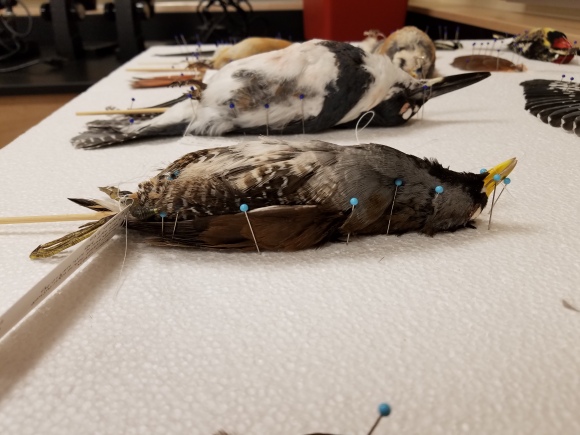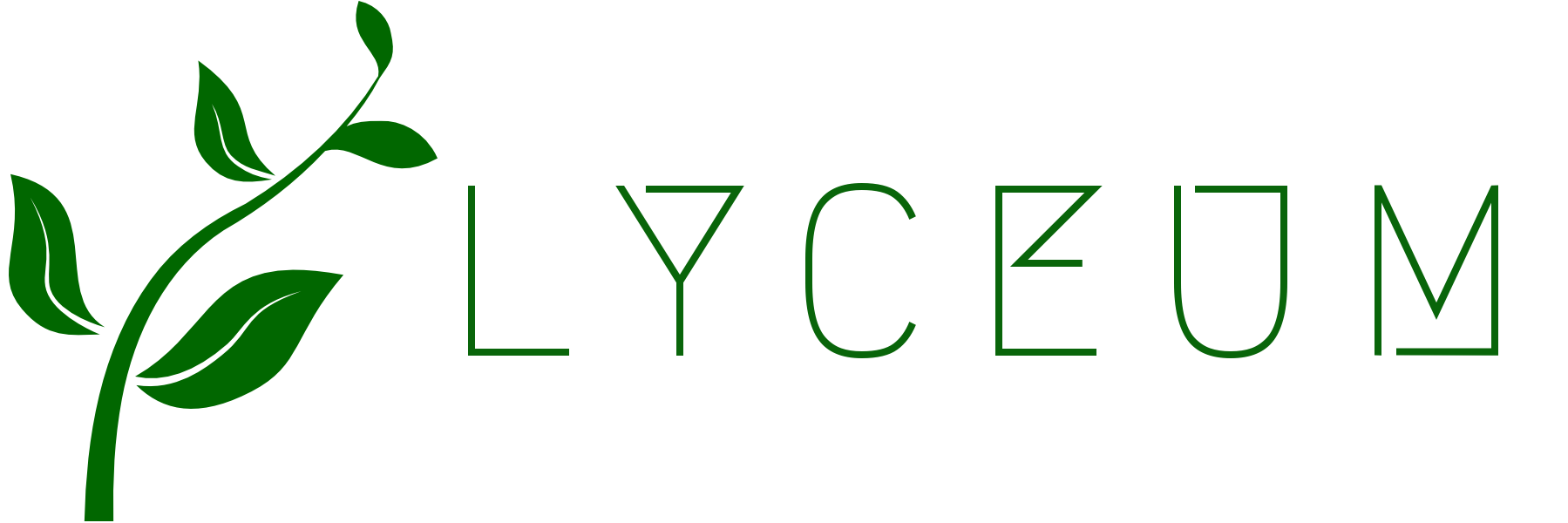Sarah Jean McPeek
“Found on the shoulder of junctions 35 and 48 in Seneca county, Ohio, May of 2015.” I copy this information onto a fresh sheet of paper along with the date of preparation: December 2017, and the scientific name, Falco sparverius. It’s a breathtaking American kestrel. Every feather is intact from the speckled belly and auburn shoulders to the slate grey and black striped wings. Aside from the odd angle of the head, you could never tell it was hit by a car.
“It’s like morbid Christmas!” I exclaimed back in October as Dr. Wright and I unpacked the kestrel from a giant Igloo cooler filled with specimen donations. At first, you’re thrilled by the beautiful bird in the bag, but you immediately feel guilty for rejoicing. Most of these birds were window strike victims or roadkill. Some had been frozen in storerooms at the back of the Cleveland Museum of Natural History for nearly a decade. I rummaged for a place to fit the kestrel among the pile of Ziploc bags accumulating in the freezer; hawks balanced on mallards shelved next to cardinals, rock doves and warblers. It felt slightly inappropriate, stacking birds like firewood.
Now in December, I gently place the kestrel on the lab table in front of me. Its feathers are wonderfully soft. This is my first time dissecting an animal that wasn’t a fat green caterpillar, and I’m eager but nervous. We don’t wear gloves. It’s difficult to manipulate our fingers and we’d risk pulling feathers that stick to the latex. Besides, Dr. Wright assures me, tucking her purple hair into a tight ponytail, there aren’t many diseases that we know of that we could catch from these specimens. She’s prepared over 1,200 birds to date, some by headlamp crouched in a tent in the Trinidadian jungle, so I trust her judgement. Handling the birds with gloves also feels too impersonal. It’s a point of respect for the animal to work skin on skin.

First, I weigh the bird on a digital scale and measure wing cord, tail length and bill length. I comb through the feathers for any damages or signs of molt. These are the same data I would take from a live animal, but it’s much easier when the subject isn’t wriggling in your palm and trying to bite your fingers or steal your pencil with its feet. I imagine those sharp, curved talons digging into the flesh of my arm. When you’re staring at a tray of surgical instruments, your thoughts tend toward the macabre.
Licking my fingers to make the feathers stick, I brush the bird’s thick breast fluff to the sides. Once I’ve exposed the pink belly from neck to hip, I make an incision at the base of the rib cage. Dark red muscle bulges through the widening gap in the chest. We use yellow corn starch to coat the exposed muscle and dry out any fat or blood that could sully the feathers. I massage some into the bird’s chest. Dr. Wright tells me to be liberal with my application; we recycle the dust by sifting away any bits of tissue. Her graduate lab used the same barrel of corn starch for years.
The first step to separating skin from body is severing the neck. With larger animals this would require a bone saw, but with birds and their hollow bones, scissors will suffice. I hear a crunch as I guide the blades through muscle, trachea and vertebrae. The head lolls backwards. From here I can slide my thumbs under the slippery skin. My progress is laboriously slow as I work the skin off the shoulders and down the back. It’s like peeling away feathered cling wrap. I’m terrified of sticking my metal probe through the skin or pulling out a handful of feathers. Dr. Wright tells me about a time back in grad school when she tugged too hard on a male mallard’s neck and came away with a shiny green head in one hand and a limp duck body in the other. Her advisor’s only advice: ‘sew it back on.’ The moral here is not to worry too much about being gentle. “A lot of taxidermy is covering up mistakes.”

She shows me where to cut the wings and legs to keep part of the bone in the skin while removing the rest of the body. I use forceps to strip every last ribbon of muscle away from the bone. The idea is to remove anything that could rot. Once I’ve completely extracted the body, I lay the bird’s skin on its back. The wings and feet splay out and the head falls to the side. Okay, now it really looks dead.
The naked body on the tray reminds me of a skinny dwarf chicken, though this bird doesn’t have a bit of fat, and it doesn’t have that meaty odor like chicken breasts. A friend once asked me if birds smell. I thought she wanted to know whether birds have a sense of smell, but she was really asking if birds give off a scent. I couldn’t answer her about living ones then, and after experiencing dead ones up close, I’d say no. Aside from a faint odor of stale blood, it doesn’t smell like anything at all.
I cut out the right breast muscle to weigh the pectoralis major and the smaller supracoracoidius that attaches the pectoralis to the shoulder. Our lab studies flight evolution, so we always gather data on the size of the flight muscle, data we can only measure when the animals are dead. Much of Dr. Wright’s work involves comparing anatomical measurements of specimens with different aspects of the bird’s life history, what we know about how it lives. What do these birds eat? What eats them? Where do they live? How high and far do they fly? By studying both living and dead birds across many different species, we can examine how a bird’s flight anatomy influences its life history, and how that anatomy has adapted through time to help birds excel in their particular environments. This bird was a strong flier.

Slicing open the bulging yellow stomach reveals the bird’s last supper: an impressive tangle of insect carcasses. At least it didn’t die on an empty stomach. I dig out the tiny purple heart and weigh it. Probing further down behind the intestines, my fingers brush two pink pearl ovaries, tiny and round but firm to the touch. I don’t know why, but it’s usually my convention to refer to animals as male until proven otherwise. Birds like falcons have few external differences to mark their sex, so the only way to tell is through surgery. At the base of the tail I find the bursa of Fabricius, which disintegrates once the bird reaches sexual maturity. She wasn’t even a year old when she died.
I’m struck with my first real twinge of sadness and I have to stop my inspection a moment. We are, were, in the same phase of life, two girls on the precipice of adulthood. She, a fierce predator swooping over golden farm fields under the wide midwestern sky; me, a budding scientist working in her first research lab. It’s pure serendipity that she is my first specimen, though it feels almost like fate. But that isn’t a very scientific way of thinking.
I dump the remains of her body into a plastic bag.
Turning back to her skin, I roll the skin of her neck and head inside out so I can access her skull. I cut a window in the back and scoop out her brain lobe by lobe. It glops onto the tray, looking more like pink icing than anatomy. I strip out her tongue. Dr. Wright cautions me to be careful about puncturing the eyeballs when I pull them out: “eyeball juice stains everything black.” I maneuver my forceps into her eye socket with extreme caution, flinching with every bulge of the membrane. But I don’t poke through, plopping one eyeball then the other neatly onto the tray. They look like overripe blueberries.
With all the gross anatomy accounted for, we move into taxidermy. I rinse the blood off my hands and fetch the roll of cotton. I poke two little cotton balls through the back of her skull to fill each eye socket. Another ball winds around a dowel rod to fill her skull cavity, and I stick the other end of the rod through the cloaca, where her eggs would emerge if she’d lived to lay them. I roll more cotton into a cone to fill her body. I want to make her nice and plump.

I never had much patience for sewing when I was younger, but now I thread each stitch to close the gap in her belly with fastidious care. The needle slides easily through her skin membrane. As I pull the final stitch through, her feathers fall into place, masking the seam. I carry her over to the counter and pin her to a Styrofoam board to dry. I poke pins between the digits on her feet to open up her impressive talons. Lastly, I initial her information tag and tie it around one of her legs. I’m proud of my handiwork. She really looks whole again. Almost alive.
Over the next couple of weeks, she’ll stiffen into what Dr. Wright calls “a nice little bird puppet.” We mount our birds on sticks so students can handle the specimens in lab without mangling their feathers. When we get through all the baggies in the freezer, we’ll have a modest sample of 75 or so birds to start our collection, hardly scratching the surface of the estimated 18,000 species currently sharing our world. My bird will represent kestrels in our humble collection for decades to come, and once we enter her data, she’ll be a messenger for her species in huge collaborative databases, participating in scientific inquiries all over the world. She’ll guide us to a better understanding of kestrels and their evolution alongside their diverse avian relatives, and how we can help protect her kin into the future. I stroke the silky feathers of her head. She’ll never know it, but she’s going to be our teacher.


